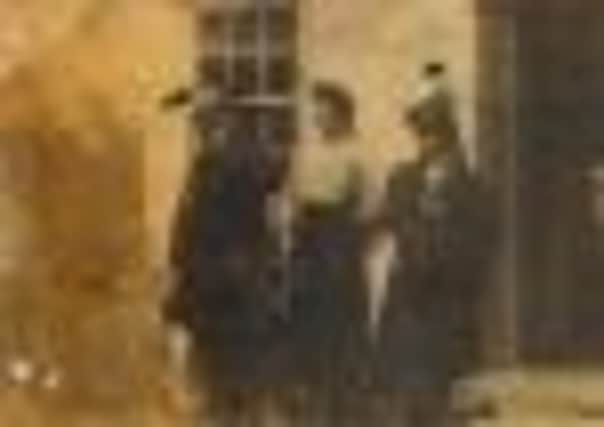One family’s journey from Ballymacash to Canada


Several unique photographs e-mailed from the other side of the Atlantic last year depict the Workmans’ ancestral cottage as it was in 1909, when some of the descendants of the family returned to the area. John Haynes, who forwarded the photographs informed me that his paternal grandmother Catherine Gowdy Haynes (nee Workman) told him that the “Workman tourists” were hugely disappointed when they visited the cottage situated in the Ballymacash area. “They had gone over with some very romanticised ideas of what the old house would look like” he said.
John Haynes great-great-great grandfather Joseph Workman was born on the 9th December 1759 to a miller, Benjamin Workman, at Moneymore. At the age of 28, Joseph went with his oldest brother, Benjamin to America. He took up employment there with the University of Pennsylvania as a mathematical tutor under his brother Benjamin who was a professor of mathematics.
Advertisement
Hide AdAdvertisement
Hide AdThe Workman family history has been penned and preserved in the form of a journal written by Dr. Benjamin Workman the eldest son of Joseph, born on the 4th November 1794 at Ballymacash. This journal includes a unique insight into the Ballymacash area during the author’s early childhood.
His recollection of cavalry, accompanied by artillery, marching past his father’s house on their way to the Battle of Antrim in 1798 emphasises the importance of his journal when exploring local history.
The “pretty painting of the wheels of the gun carriages” was a striking image to young Benjamin. He also recalled his mother lifting him up one evening so he could see over the thorn hedge and witness the “lurid glare arising from the burning of the village of Ballynahinch on the evening of the battle that was fought there.”
The journal’s author informs us that his father Joseph Workman left Philadelphia in 1790, due to ill health and sailed to London. Whilst there he was intent on patenting an improvement to the mariner’s compass which had been invented by his older brother Benjamin.
Advertisement
Hide AdAdvertisement
Hide AdHowever, he discovered the mechanic who had made some of the parts for Benjamin had already fraudulently patented it as his own. On returning to Ireland, Joseph became a teacher, firstly at Milltown, Derriaghy and then Ballymacash.
The school-house at Ballymacash had been built in 1790 by the Rev Phillip Johnston, who was then vicar of Derriaghy Parish Church. He appointed Joseph to be schoolmaster. It was there he met his future wife, Catherine Gowdy, the eldest daughter of the Rev. Johnston’s land steward, Alexander Gowdy.
The position of land steward was given to Gowdy on the death of his father but he was unable to perform the role satisfactorily and eventually Joseph Workman was given the position and later was appointed deputy clerk of the peace by the Rev Johnson.
Benjamin Workman informs us that these duties called his father away almost on a daily basis and as a result “his retirement from the school deprived the vicinity of that educational means.” The journal records that Joseph was given the schoolhouse to reside in. He would later secure a plot of land about five and three quarter acres and he built a schoolhouse there.
Advertisement
Hide AdAdvertisement
Hide AdMost likely this is the building situated at Ballymacash corner, later used by St. Mark’s Parish Church as a hall and now a retail outlet.
Benjamin informs us that a family called Gribben resided in the house adjacent to the Workman family in 1806. Records in the 1860 period show there were still a family of Gribbens residing in a row of buildings, presumed cottages, on what is now the Nettlehill Road, on the upper side of the old schoolhouse, on the opposite side of the road.
Benjamin eventually went into the teaching profession and later taught at Mullaghcarton school. In 1817, whilst sitting at an evening meal at Ballymacash, he observed 11 beggars entering the gate of his father’s house and asking for alms. This image had a powerful effect on him and would be the catalyst for him deciding to seek his fortune on the other side of the Atlantic ocean.
On the 27th April, 1819 he bade farewell to his family and neighbours at Ballymacash for a new life in Canada. He records this event in great detail in his journal. It was the last time he would see the home of his childhood.
Advertisement
Hide AdAdvertisement
Hide AdHe recalled that his last vision of the family home was on the apex of a hill he refers to as “Bawn’s Hill.” It is likely this was at the brow of the hill on the Nettlehill Road, or at the junction of the Pond Park Road, Lisburn.
Benjamin’s younger siblings - Alexander, John, Joseph, William, Ann, Samuel, Thomas and Matthew Francis, together with their parents, would all eventually all follow him to Canada.
Alexander, who married Mary Abbott from Magheragall, went in 1820. There is an interesting entry in the Orange lodge records of Ballymacash LOL 317 dated the 13th April, 1820 in relation to Alexander Workman’s departure. He and William Brady, both members of the lodge, had been granted a certificate “previously to them going to America.“
Seven years later, Samuel, Thomas and Francis arrived, and by 1829 the remainder of the Workman family had also emigrated.
Advertisement
Hide AdAdvertisement
Hide Ad